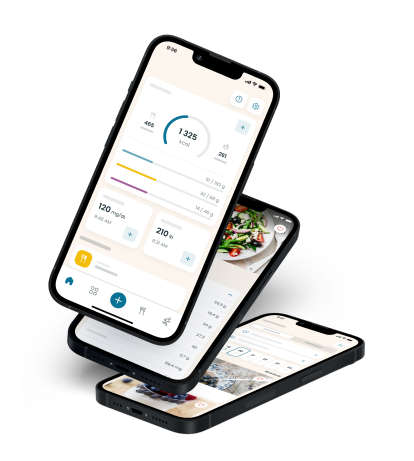Table of contents
What is diabetes?
What is diabetes?
Diabetes refers to several conditions in which the body cannot use insulin effectively or doesn't produce enough of it. Insulin is a hormone secreted by the pancreas to help glucose fuel the cells in your body. Most of the food you eat ends up in the body as glucose, the primary energy source for cells.
Diabetes leads to a buildup of glucose or sugar in your blood, which has adverse health effects. As diabetes progresses, high blood sugar or hyperglycemia can damage tissues and organs.
Diabetes definition
Simply put, diabetes is a chronic condition that occurs when your blood sugar levels are too high. Another common diabetes definition refers to it as a condition in which the body cannot process food to use energy the way it should.
Diabetes has long been considered a metabolic condition. But as we'll see, new research indicates that type 2 diabetes, similar to type 1 diabetes, may be an autoimmune disease.
How do you get diabetes?
Diabetes is a chronic disease caused by the body's inability to properly use blood sugar (glucose). The precise cause of this malfunction is unknown, but genetic and environmental factors are likely to play a role. Obesity and high cholesterol levels are one of the main risk factors for diabetes.
Diabetes complications
Diabetes may give rise to many complications, including:
Cardiovascular disease
Stroke
Vision loss
Neuropathy
Depression
Dementia
Foot damage
Skin conditions
Diabetes affecting pregnant women increases the risk of caesarian delivery, premature birth, jaundice, and stillbirth.
Living with diabetes means paying attention to the glycemic index of foods, adapting to new meal plans, and exercising more. But it doesn't have to mean giving up your favorite dishes or activities you enjoy.
Types of diabetes
Diabetes is a broad term that refers to several related but distinctive conditions. It's important to make the distinction between type 1 diabetes, type 2 diabetes, gestational diabetes, and prediabetes. Let's take a closer look at each one of them.
Type 1 diabetes: This type of diabetes, formerly called insulin-dependent diabetes or juvenile diabetes, occurs when the pancreas fails to produce sufficient insulin. Deprived of this hormone, cells cannot absorb blood sugar, which builds up in the bloodstream beyond normal levels.
Type 2 diabetes: The most prevalent form of diabetes, which causes chronic high blood sugar levels. The body does not use insulin effectively enough to stabilize blood sugar levels. Therefore, some tissues, for example, become insulin resistant and require more insulin.
Prediabetes: A condition in which blood sugar levels are higher than normal but not high enough to be diagnosed as type 2 diabetes yet. Blood sugar, blood pressure, and insulin resistance may have reached dangerous levels by this point.
Gestational diabetes: Also known as pregnancy diabetes, this type refers to high blood sugar that appears during pregnancy, usually in the second or third trimester. This condition tends to disappear after childbirth.
Diabetes symptoms
According to the Centers for Disease Control and Prevention, common diabetes symptoms include:
Frequent need to urinate
Feeling thirsty
Feeling hungry despite eating
Losing or gaining weight without explanation
Feeling tired constantly
Noticing sudden changes in your vision
Having sores that don't heal quickly
Having more infections than usual
Experiencing numbness or tingling in your feet or hands
In addition to these symptoms, people with type 1 diabetes may also experience stomach pain, nausea, vomiting, and mood changes.
Diabetes symptoms are not always obvious and can be hard to notice. Not everyone with a high blood sugar level experiences them. Many people realize they have diabetes only after routine blood tests rather than due to their symptoms.
Diabetes symptoms in men
Men with diabetes may also experience one or more of the following symptoms:
Reduced muscle strength
Erectile dysfunction
Decreased sex drive
Diabetes symptoms in women
Women with diabetes are more likely to experience a few other symptoms:
Dry skin
Itchy skin
Yeast and urinary tract infections
Key diabetes statistics
Diabetes affects millions of people worldwide and costs billions of dollars to manage. Here are the key diabetes statistics at a glance:
38.4 million
people in the US, or more than 1 in 10, have diabetes.
est. 8.7 million
have undiagnosed diabetes.
27.2 million
Americans over the age of 65 have prediabetes.
97.6 million
Americans aged 18 and older had prediabetes in 2019.
$327 billion
is the estimated cost of diabetes in the US, including medical costs and reduced productivity, according to the 2017 report.
7 th
highest cause of death in the US is diabetes.
5 %
is the increase from 2000 to 2016 in premature mortality from diabetes, according to the World Health Organization.
102.9 %
is the increase from 1990 to 2017 in diabetes incidence worldwide, according to the Global Burden of Disease Study 2017.
Preventing diabetes
When talking about preventing diabetes, people usually refer to type 2 diabetes. Despite extensive research, no safe and effective methods for preventing type 1 diabetes have been identified yet.
Type 2 diabetes, on the other hand, can be avoided or delayed for many people, which is great news if you believe you might be diagnosed with it.
Making healthy lifestyle changes can help lower your risk of developing type 2 diabetes. The most effective ways to reduce the risk of developing type 2 diabetes are to eat healthier to especially keep your blood glucose levels at a normal range, move more, and lose weight if overweight.

Managing diabetes
Managing diabetes requires a personalized approach based on continuous monitoring and testing.
People with type 1 diabetes need to have insulin injected or delivered through a pump to survive. Without insulin, muscles and other cells would be starved of energy.
By contrast, those with type 2 diabetes can manage their condition through blood glucose control, a healthy diet, and regular exercise. They have to replace sugary and starchy food with diabetes-friendly alternatives. The aim is to lower their daily carbohydrate intake to maintain their blood sugar levels within a manageable range and potentially lose a healthy amount of weight.
Eating small, healthy meals daily can also help with type 2 diabetes management.
Takeaway
Unlike type 1 diabetes which is caused by factors beyond your control, type 2 diabetes is more preventable.
Healthier food choices, losing weight, and becoming more active can help you manage type 2 diabetes, prediabetes, and gestational diabetes while increasing your quality of life.
Diabetes is a serious medical condition, but there's a lot you can do to keep it under control and, in some cases, even to revert it. It all starts with healthy lifestyle choices.
Take a quiz and get your diabetes-friendly meal plan today!

Related articles

What is type 1 diabetes?
10 min read•January 8, 2024

What is type 2 diabetes?
11 min read•January 15, 2024

What is prediabetes?
6 min read•January 26, 2024

What is gestational diabetes?
7 min read•December 10, 2023
Resources
Blog